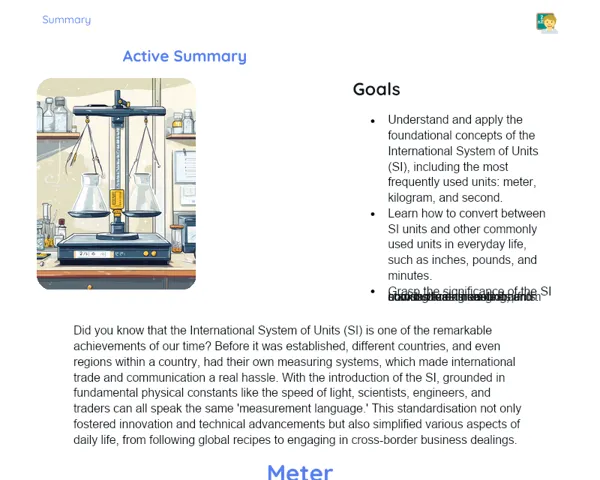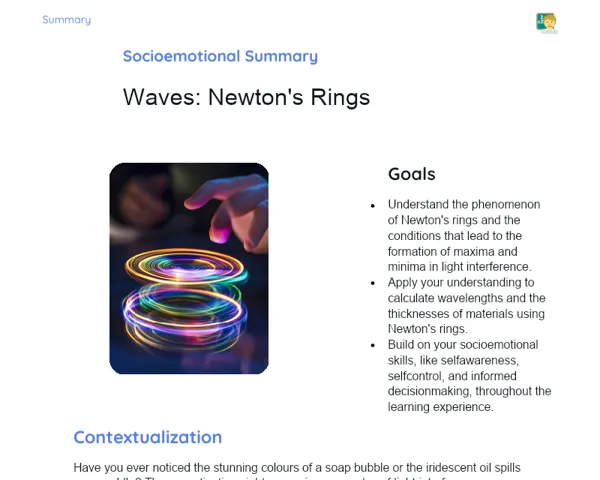Summary Tradisional | Gravitation: Escape Velocity
Contextualization
Gravity is the force that draws objects with mass toward each other, keeping us firmly on the ground and controlling the orbits of planets. In our everyday lives, we experience gravity as the invisible force pinning us to the Earth. For an object to break free from a planet’s gravitational grip, it must reach a particular speed known as escape velocity. This concept is vital for space exploration, as it sets the minimum speed needed for a rocket or any other object to leave a planet's orbit and venture into outer space.
Escape velocity is determined by two key factors: the mass of the celestial body and its radius. The formula to calculate escape velocity is v = √(2GM/R), where G is the gravitational constant, M is the mass of the celestial body, and R is its radius. For example, Earth's escape velocity is about 11.2 km/s, while the Moon's is approximately 2.4 km/s due to its smaller mass and size. This distinction explains why rockets launching from the Moon require significantly less energy than those launched from Earth. Grasping this concept is crucial for the planning and successful execution of space missions.
To Remember!
Escape Velocity Concept
Escape velocity is the minimum speed required for an object to escape the gravitational influence of a celestial body without returning. This concept is essential in gravitational physics and space exploration. Picture throwing a ball upwards; if you give it enough force, it can completely break free from Earth’s gravitational pull and won’t fall back. This necessary speed is referred to as escape velocity.
It’s also closely linked to energy dynamics. For an object to flee gravity, it must possess adequate kinetic energy to overcome the negative gravitational potential energy. The greater the mass of the celestial body, the higher the gravitational potential energy and, consequently, the increased escape velocity needed.
Escape velocity is relevant not only for rockets and space probes but also for understanding astrophysical phenomena like the birth of black holes. In black holes, the escape velocity surpasses the speed of light, indicating that even light cannot escape, rendering them invisible.
-
Minimum speed needed to escape the gravity of a celestial body.
-
Related to kinetic energy and gravitational potential energy.
-
Significance in astrophysics and space exploration.
Escape Velocity Formula
The formula for escape velocity is expressed as v = √(2GM/R). In this equation, 'v' denotes escape velocity, 'G' is the gravitational constant (6.67430 × 10^-11 m^3 kg^-1 s^-2), 'M' represents the mass of the celestial body, and 'R' signifies the radius of the celestial body. This formula is derived through energy conservation, asserting that the kinetic energy of the object must match the negative gravitational potential energy.
The gravitational constant 'G' is a fundamental constant in physics that outlines the strength of the gravitational pull between two objects. The mass 'M' of the celestial body conveys the amount of matter it harbours, and the radius 'R' is the distance from the centre of the celestial body to its surface. Together, these values determine how much energy is needed for an object to escape gravitational pull.
Using this formula allows us to compute the escape velocity of various celestial bodies like planets, moons, and stars. This information is crucial for mission planning, as it informs us of the energy and fuel demands required to launch a rocket into space.
-
Formula: v = √(2GM/R).
-
Gravitational constant, mass, and radius of the celestial body.
-
Application in space exploration and mission planning.
Derivation of the Formula
The escape velocity formula can be established based on the principles of energy conservation. The total energy of an object within a gravitational field includes its kinetic energy (KE) and its gravitational potential energy (PE). For an object to break free from gravitational attraction, its kinetic energy must equal the negative gravitational potential energy.
Kinetic energy is represented as KE = 1/2 mv², where 'm' is the object's mass and 'v' is its speed. Gravitational potential energy is described as PE = -GMm/R, where 'M' embodies the mass of the celestial body, 'G' is the gravitational constant, and 'R' indicates the celestial body's radius. In order for the object to escape, KE + PE must equal 0, leading us to the formula v = √(2GM/R).
This derivation process not only confirms the formula but also deepens the understanding of kinetic and potential energy concepts and underscores the significance of energy conservation in physics. It presents an excellent opportunity for students to apply mathematical and physical principles to tackle complex problems.
-
Based on energy conservation.
-
Kinetic energy and gravitational potential energy.
-
Confirmation and comprehension of the formula v = √(2GM/R).
Applications in Space Exploration
Escape velocity is fundamental in space exploration. For a rocket or probe to escape a planet’s orbit and travel through space, it must reach or surpass that planet's escape velocity. For instance, a rocket launched from Earth needs to achieve about 11.2 km/s to break free from Earth’s gravity and venture into outer space.
In space missions, calculating escape velocity is critical for ascertaining the fuel and energy required for takeoff. This affects rocket design, payload capacity, and flight path. Understanding escape velocity is also essential for the re-entry of spacecraft into Earth’s atmosphere, where speeds must be meticulously controlled to guarantee a safe return.
Moreover, escape velocity has consequences for exploring other celestial bodies. For example, the Moon’s escape velocity is much lower than Earth’s, facilitating easier launches for rockets and probes from its surface. The study of Mars and other planets also hinges on this knowledge, paving the way for more efficient and safer missions.
-
Crucial for launching rockets and probes.
-
Impacts design, fuel needs, and trajectory of space missions.
-
Key to exploring other celestial bodies.
Key Terms
-
Gravity: The force that attracts objects with mass to one another.
-
Escape Velocity: Minimum speed necessary to break free from gravitational pull.
-
Gravitational Constant (G): 6.67430 × 10^-11 m^3 kg^-1 s^-2, describes the strength of the gravitational force.
-
Kinetic Energy: The energy possessed by an object due to its motion.
-
Gravitational Potential Energy: Energy related to an object's position within a gravitational field.
-
Conservation of Energy: The principle that the total energy of an isolated system remains constant.
-
Escape Velocity Formula: v = √(2GM/R), where G is the gravitational constant, M is the mass of the celestial body, and R is its radius.
Important Conclusions
In this lesson, we delved into the concept of escape velocity, a crucial element in gravitational physics and space exploration. We learned that escape velocity is the minimum speed required for an object to break free from the gravitational force of a celestial body. Additionally, we explored its mathematical formulation v = √(2GM/R), where G represents the gravitational constant, M is the mass of the celestial body, and R is its radius.
We also derived the escape velocity formula from energy conservation principles, reinforcing the link between kinetic and gravitational potential energy. We applied this knowledge through practical examples, calculating the escape velocities of Earth and the Moon, and engaging in discussions about the significance of this concept in the planning and execution of space missions.
Finally, we emphasised the relevance of escape velocity in space exploration, from the design and launch of rockets to the re-entry of spacecraft into Earth's atmosphere. A solid understanding of this concept is indispensable for the successful execution of space missions and for exploring other celestial bodies, like the Moon and Mars.
Study Tips
-
Revise the escape velocity formula and practice solving calculation problems for various planets and moons. This will solidify your grasp of the formula and enhance your understanding of how the variables influence the outcome.
-
Explore more about energy conservation and the interplay between kinetic and gravitational potential energy. Understanding these foundational concepts will facilitate the application of the escape velocity formula.
-
Research space missions and the role of escape velocity in planning these endeavors. This will provide a more contextualised and practical understanding of the topic.



